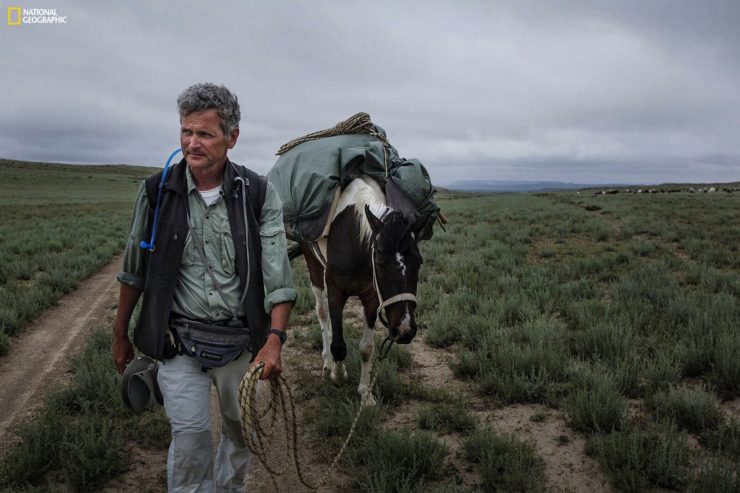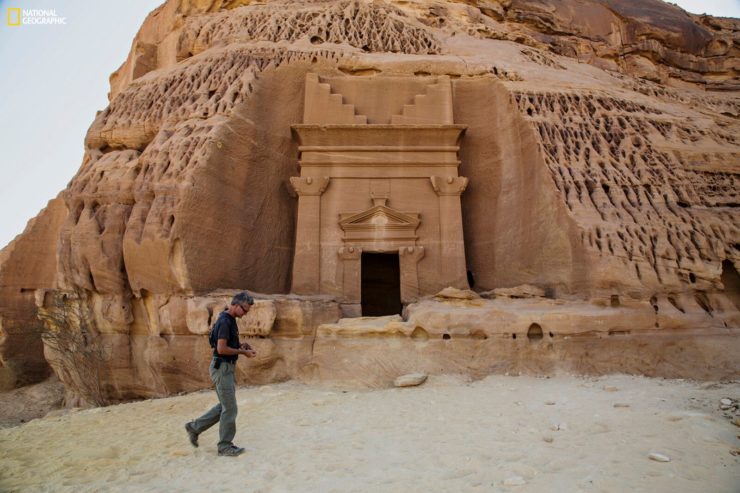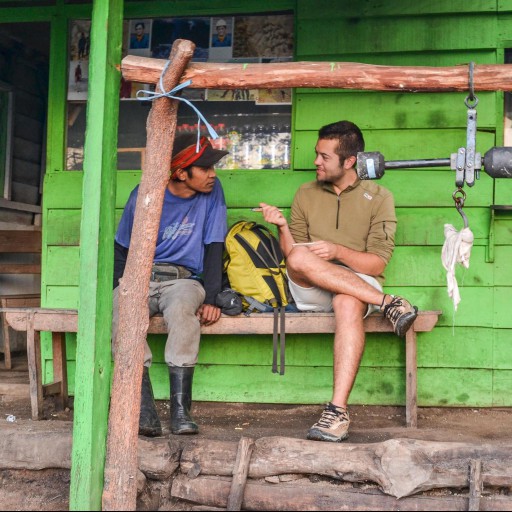
National Geographic Fellow Paul Salopek is making a years-long trek for the "Out of Eden Walk" project.
It all started with a dusty photo album and a torn children’s map of the world.
After countless hours spent sitting cross-legged on the cold concrete floor of our unfinished basement, my 10-year-old self fell in love with the concept of travel. I would gently turn the yellowing pages of my mom’s college scrapbook for hours, studying every creased photo from her study-abroad adventures until I felt like I had experienced every moment with her. Whenever I discovered a new place, I would scurry across the room to find it on the colorful map thumbtacked to the stucco wall. My index finger would trace the valleys and plateaus of that wall until I located the correct spot on the map.
Seeing these faraway lands on the map made them real to me. The second I knew where they were, I could begin dreaming of what it would be like to see them for myself.
In junior high, my grandma bought me a subscription to Travel + Leisure, and I began consuming it as eagerly as I did the travel section of the Chicago Tribune that awaited me on the kitchen table every Sunday morning.
When I think of the travel writing that dominated my life then, I think of the Rick Steves columns in the Tribune that taught me how to navigate the winding cobblestoned streets of Europe. I think of the glossy issues of T+L that made me fantasize about big, ritzy yachts and the glimmering islands they glided by.
However, I don’t remember reading anything that taught me how these distant places felt. I knew how beautiful they were, but I didn’t understand their real beauty: the rich history of their architecture, the eclectic nature of their nightlife or the warmness of their people. I remember countless how-to service pieces, but not many take-me-there experiential pieces.
It wasn’t until I discovered the notion of writing about “place” during my early years as an undergraduate studying journalism at the University of Missouri that I realized that perhaps travel writing isn’t what I want to do for the rest of my life. I want to travel, but I also want to tell stories. I want to get to know people – what brought them to their spot on the map, how they shaped that spot and were shaped by it.
What makes a work a piece of “travel writing”? Where do we draw the line between writing about “travel” and writing about “place”? I turned to a few writers who have straddled this line to find an answer.
Lauren Quinn
Lauren Quinn is a Los Angeles-based high school English teacher with experience as a writer and editor. She’s written for the San Francisco Chronicle, the Guardian and a wide array of digital publications. Her piece “Mr. Nhem’s Genocide Camera” for The Believer was included in Best American Travel Writing 2015, and her piece “On The Rails in Phnom Penh” for Vela was included in Best Women’s Travel Writing Vol. 9. in 2013.
Quinn was stuck in her daily commute through L.A. traffic when I spoke with her over the phone about the concept of travel writing. When I asked her how she got started in the genre, her words were as brash as the language often reserved for rush-hour road rage: “The bar was so low in travel writing that I couldn’t fuck it up, basically,” Quinn said.
She admits that one of the initial lures of travel writing was the fact that it’s much more commercial than other genres. But that’s also a drawback: She thinks that in order to be a true travel writer, you have to sell yourself out, to an extent.
“Sometimes you have to write something that’s not the story you wanted to tell but it’s the story that’s consumable,” she said. “It’s a lot of the same old story. It’s an educated, middle-class, Western person in a fill-in-the-blank space discovering something.”
Quinn cited a comment she once heard from a fellow writer frustrated with the notion that travel writing seems to always be about white people discovering something about themselves.
“It’s a lot of the same old story. It’s an educated, middle-class, Western person in a fill-in-the-blank space discovering something.”
“Travel is still, ultimately, a privilege,” Quinn said. “Travel for leisure is a privilege, and to get to even write about that is a privilege, so you kind of get this one voice and it feels very singular.”
She believes that when she was doing travel writing, she was often lumped with the likes of “Eat, Pray, Love”-type writers whose focus is on the “other” and what society can learn from those who are different. She recognizes that she might have fit this description from time to time, especially because she was the epitome of the white writer discovering herself in a foreign place, but she made a conscious effort to get to know the people and the history of the places she wrote about.
“I think because of my training in literary writing — my undergraduate degree is in poetry — I was trained to look for the deeper story,” she said. “I think I was getting close to it in Cambodia. In order to really do that and achieve that, I think you really need to be able to spend time in a place and have a sharp perception. I was getting there.”

National Geographic Fellow Paul Salopek is making a years-long trek for the "Out of Eden Walk" project.
Paul Salopek
Paul Salopek is a two-time Pulitzer winner and National Geographic Fellow who’s worked as a foreign correspondent on five continents. He’s written pieces that have appeared in the Chicago Tribune, The Atlantic, “America’s Best Travel Writing,” and many more publications. Salopek is in the middle of a years-long project, the “Out of Eden Walk,” documenting his journey by foot along the migration pathways of humankind from Ethiopia to Tierra del Fuego. (He has a Kickstarter campaign here to help fund it.)
Like Quinn, Salopek doesn’t consider himself a travel writer. Although his work has been featured in travel writing anthologies, he says the majority of his work is more general, ranging from topics such as politics and war to human rights and migration.
“I don’t find conventional travel writing, as a genre, easy to understand or very interesting,” Salopek said. “I don’t take holidays to ‘faraway places.’ So travel for travel’s sake… isn’t what I normally write about.”
Salopek said he thinks that the characteristics that define the kind of writing he does are similar to the traits that define “good narrative”: an original question the writer aims to answer, carefully chosen observations that turn into details, and a point of view.
“I don’t find conventional travel writing, as a genre, easy to understand or very interesting. I don’t take holidays to ‘faraway places.’ So travel for travel’s sake… isn’t what I normally write about.”
“If you want to be bored instantly to death, and to fail dismally as storyteller, then write the way a live-film of a typical climb of Mount Everest would look. Record every single bite of granola. Every single rope knot. Every stray (and often banal) thought that slides through your head,” he said. “A writer’s job, by contrast, is to select only the most telling shards in a bigger mosaic of real experience, and from that handful of colors build a much smaller, symbolic mosaic called a ‘story’ –a story that hopefully carries more meaning than the real thing.”
For Salopek, writing about a place is best done by writing about its people, and he’s done this during his many years in the field by holding manual jobs in order to get a deeper look into the everyday lives that make up a community.
“The quickest way to access most people’s lives is through their work: pick oranges and grapes, fuel commercial aircraft, install walk-in freezers,” he said. “This is valuable to me because my destinations aren’t places, but people.”

Mark Johanson is a freelance travel writer who proudly owns the label.
Mark Johanson
Mark Johanson is a freelancer for CNN, BBC and various magazines whose focus is in travel, food and culture writing.
Unlike Quinn and Salopek, Johanson is a self-declared travel writer, but he said it can be a difficult field to work in.
“People on the outside think that when you’re a travel writer, you get to sit on beaches and have piña coladas and it’s all fun. And it can be fun, but it’s definitely a lot of hard work.”
“The people who do it are the people who really seek it out and do everything they can to make it happen because there’s so much competition out there,” Johanson said. “There are far more people who want to be travel writers than the amount of work that is out there.”
Regardless of such difficulties, Johanson pursued this career “wholeheartedly.” He read books on how to become a travel writer and studied the craft until he found a niche that worked for him. He said it’s an industry that’s growing and will always be around because people are interested in travel, but the tricky part is finding a new angle to maintain that interest.
“I think it’s [about] finding a lens from which you want to show a destination or a part of the world,” he said. “How many people have written a story about Paris? How many people have written a story about New York? Can you show those places from an angle or through a lens from which nobody else has? That’s what makes you stand out.”
Johanson said a major challenge is battling the perceptions of others in regard to what his job actually entails.
“People on the outside think that when you’re a travel writer, you get to sit on beaches and have piña coladas and it’s all fun. And it can be fun, but it’s definitely a lot of hard work,” he said. “A lot of what you do is verifying facts and seeking out sources. You could be working from the second you wake up to the second you go to bed.”
Niki Kottmann graduated from the University of Missouri’s School of Journalism with a degree in magazine journalism in May. She works in Sarasota, Fla., as a writer and photographer for the Black Tie/Arts and Entertainment section of the Observer newspaper.

